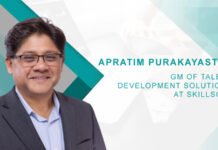1. Tell us about your role in StarLinks?
I am the founder and CEO of the company
2. Can you tell us about your journey into this market?
Building StarLinks was a natural progression of my research and work. I am an Organizational Psychologist and always loved to bring together data analytics and practice. On my academic journey, I researched leadership from a relational perspective and my dissertation looked at the integration of newcomers into the informal organizational network. StarLinks is the culmination of this (and other) research into simple day- to- day practices. The micro-practices in StarLinks are based on numerous approaches and methodologies for personal, team, and organizational development. As an organizational psychologist, I focused on relationships as the key to unlocking great value, but my reach was local and limited. Even within the same company, there was no way to help everyone build their networks more effectively. Gratefully, data and technology enabled me to found StarLinks and scale social capital development in companies.
3. How do you think technology is changing the HR Sector?
Unfortunately, much of the HR technology right now is innovative but not disruptive. In most cases, the tech is used to make current HR processes more effective and efficient. However, I believe we need to rethink our processes altogether.
We are in the midst of a mindset shift (for example, from hierarchies to networks) where traditional assumptions are not holding for our new reality.
Organizational formal structures and current processes can’t keep up with changes and this is the main challenge we need to solve. This is not a technological challenge but rather a cultural one. Disrupting the 150 years-old hierarchical model is not easy, to say the least, but I believe this is where HR tech will be going. New HR technologies should give HR professionals the tools to take their companies into the future, helping them build networked companies that can innovate and execute fast.
4. How has data-driven approach optimized the functions of HR professionals?
We are only just beginning to see the impact of data on HR practices. The awareness to the potential of using data for making people-related decisions has grown exponentially over the past few years. However, just like my previous comment on technology, the same is true with the use of data. Technology and data are tools that HR is getting more exposed to right now– but the focus on leveraging these tools in still made from a traditional mindset. Right now the approach is to use the data to better inform HR and managers so they can make better people-related decisions. However, I find the potential of data and technology to be far greater than that.
Data and technology can be used to create a shift in the way we work and can allow HR to better support emerging organization needs. We can enable people at all levels of the company to make decisions, we can flatten hierarchies and use the wisdom of the crowds in dramatic new ways, and we can use blockchain technology to change models of compensation. We have the opportunity to align people and business, allowing people to bring themselves to work with energy. We can use data and technology to provide people with space to make an impact and feel meaningful. There is just so much more we can do with data for people within the business that we haven’t really started exploring yet. When we will do that, companies will thrive. Da-Vinci said “learn how to see. Realize that everything connects to everything else”. The flourishing of people, companies, and the human society at large are connected. If we will bring data and technology to aid the smallest units within the system (the people) it will be a win-win-win situation.
5. How does your gamified method help in connecting the people in an organization?
Gamification is not really about games; it is about motivation. The use of gamification in StarLinks is aimed at fostering our inner motivation for collaborating with others. If you think about it, we already have gamification in companies. We have titles, designated parking spots, corner offices and all of these are ‘badges’. If the badges are meaningful, people are motivated to pursue them. Unfortunately, in many cases the motivation to get these ‘organizational badges’ promote negative competitive behaviors as there are few opportunities to get them. StarLinks uses this same concept of ‘badges’, but our badges focus on network performance and position, and so they promote collaborative behaviors. If you think about it, people are intrinsically motivated to connect and collaborate, and we also like to be recognized for our contribution. This intrinsic motivation gets a voice through StarLinks’ badges, making the badges meaningful for people to attain. Moreover, as the badges are data-driven they are free of biases associated with other collaboration indicators (e.g. 360s). Reduced biases make StarLinks’ badges even more meaningful. The use of badges is just one example, but it captures the spirit of how we use gamification to promote collaborative behaviors and culture.
6. Can you explain how connected people drive exponential growth of an organization?
There is a vast amount of research from various disciplines (e.g. Sociology, I-O Psychology) that demonstrates connectivity matters. My own research showed newcomers-insiders interactions in the newcomers first week of work had an impact on the development of support relationship three months later. Right now our approach to connecting newcomers and insiders in their first week is neither systematic nor data-driven. With StarLinks we use data to help newcomers connect with the insiders that can speed-up their integration process. But newcomers are just one example. GM increased team productivity by up to 25% by increasing team cohesiveness; CEB demonstrated a 5% profit increase for BUs with a higher percentage of employees demonstrating network performance; and years of social capital research summarized by Adler and Kwon showed the wide impact of social capital in companies (e.g. retention). Taking these different research together we can safely say desired outcomes such as productivity, innovation, leadership, learning, well-being, retention are greatly influenced by patterns of connectivity. So, by tapping into the white space between the individual talents in a data-driven and research-based manner, StarLinks unleashes hidden potential and drives exponential growth for people and companies alike.
7. How do you differentiate your platform from your competitors?
At StarLinks we take the world of People Analytics and put it at the service of the people themselves. This is a very different approach in the world of People Analytics platforms. We use company data alongside individual inputs and turn it into action-based guidance for people interested in building their personal brand and positive impact.
8. What advice would like to give to the upcoming HRTech Start Ups?
I am not sure if it’s advice or a request. Like I said before, I would suggest focusing on changing the world of work rather than making the one we have more effective. As I see it, the times we live in provide us with great opportunities for making an impact. This is the time for entrepreneurs to rewrite the rules so the way companies work will match with the fast-moving, highly complex environment we work in. Making current processes more efficient is just not enough anymore, we need to envision the future world of work and build the tools that will enable companies to take the leap into the future.
9. How do you prepare for an AI-centric World?
I make sure to learn, ask questions, identify opportunities, and clear away the hype and noise. But most importantly, as a founder and CEO of a company using data and AI, I put ethical, psychological and sociological considerations at the top of my decision-making criteria for how StarLinks uses AI.
10. Can you tell us about your team and how it supports you?
I am a really lucky person as I get to work with the brightest minds and the biggest hearts. StarLinks started with me but the current product and value proposition has shaped and grown as more minds and perspectives came in. We are about to expand so even greater things are about to come.
11. Which Book are you reading these days?
I mostly listen to books these days, and the one I just finished is Beyond Measure by Margaret Heffernan. My next book on the listening list is Simple Rules by Donald Sull and Kathleen Eisenhardt. Both of these books touch on the simple rules/actions that can drive complex changes, which is, in essence, the core principle StarLinks is built around. In her book, Margeret Heffernan gives examples of small changes (e.g. embracing conflict and using every mind on the team) that can bring about substantial changes for the business. Simple Rules is another book around these lines where simple rules are used to manage great complexity. I would also recommend The Social Atom by Mark Buchanan for people interested in that line of thought.

Michal Gradshtein Founder and CEO, StarLinks
Michal is the founder and CEO of the startup company StarLinks, which drives the networked organization bottom-up by providing people analytics directly to the people. Michal has work experience in global organizations such as P&G and Bosch PT and in a variety of industries (e.g. communication, higher education, agriculture, and government). She holds a M.Sc. with honors in Organizational Psychology from The Illinois Institute of Technology (IIT) in Chicago.
Michal Gradshtein is an organizational psychologist with a network perspective. Michal focuses on the relationships between people and perspectives as the core mechanism to drive performance, engagement, creativity, agility, and other desired outcomes for organizations. As an independent consultant, Michal helps organizations and their people create a culturally directed space for emergence; leverage existing network structures; and build inclusive mental models.












